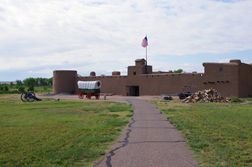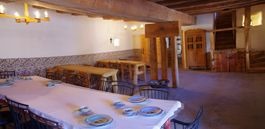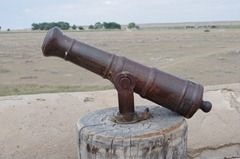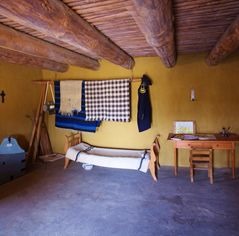Several years ago, I did quite a bit of research on a National Historic Site I had never visited, Bent’s Old Fort, just north of the Arkansas River in Southeastern Colorado, near La Junta. It was one of the places I wanted to see on this trip and we visited the fort September 7th, 2011, a breezy and chilly morning.
It was very, very interesting, exceeding all of what I remembered of that long ago research.
The fort is actually a reconstruction based on drawings by Lt. James Abert in 1846.
It’s amazing to think that this location was actually on the border between the United States and Mexico back then.
Bent’s Old Fort National Historic Site was the first place I selected for an online travel project that never came to full fruition. The material that I developed from that research is included below, along with a few photos from our visit.
William Bent, Charles Bent and Ceran St. Vrain were among the earliest western fur traders and, in the 1820’s, began to engage in the Mexican and Indian trade. There were five Bent brothers. For thirty years their name was almost synonymous with the fur trade of Colorado.

In 1831 or 1832 Charles Bent and St. Vrain formed a partnership, which in time became Bent, St. Vrain, and Co., and entered the Santa Fe trade. In the late 1820’s or early 1830’sWilliam Bent, who had apparently been trading independently, erected a large adobe fort on the north bank of the Arkansas River, 12 miles west of the mouth of the Purgatoire. At first named Fort William, it was also known as Bent’s Fort and finally as Bent’s Old Fort after it was partially destroyed and a new fort was built elsewhere. Elaborately constructed, it was eventually a massive adobe structure of quadrangular shape having 24 rooms lining the walls, supported by poles. Two 30-foot cylindrical bastions, equipped with cannon, flanked the southwest and northeast corners. The walls were 15 feet high and 2 feet thick and extended 4 feet above the building roofs to serve as a banquette and were pierced with loopholes. On the south side was a cattle yard, enclosed by a high wall. A self-sufficient institution, the fort was operated by about 60 persons of many nationalities and vocations, including blacksmiths, trappers and traders, carpenters, mechanics, wheelwrights, gunsmiths, cooks, cattle herders, hunters, clerks, teamsters, and laborers.
 Bent’s Fort became the center of the Bent, St. Vrain Company’s trading empire which reached from Fort St. Vrain in the north to Fort Adobe in the south. The company also had stores at Taos and Santa Fe in what was then Mexico. A primary trade was for buffalo hides with the Cheyenne, Arapaho, Arikara, Comanche, Kiowa, Shoshone and Sioux Indians. Constructed of adobe due to the scarcity of lumber, for most of its 16 years, it was the only permanent white settlement between Missouri and the Mexican settlements. For explorers, adventurers and the U.S. Army, the fort provided supplies, livestock, company and a place for protection in what was known as the Great American Desert.
Bent’s Fort became the center of the Bent, St. Vrain Company’s trading empire which reached from Fort St. Vrain in the north to Fort Adobe in the south. The company also had stores at Taos and Santa Fe in what was then Mexico. A primary trade was for buffalo hides with the Cheyenne, Arapaho, Arikara, Comanche, Kiowa, Shoshone and Sioux Indians. Constructed of adobe due to the scarcity of lumber, for most of its 16 years, it was the only permanent white settlement between Missouri and the Mexican settlements. For explorers, adventurers and the U.S. Army, the fort provided supplies, livestock, company and a place for protection in what was known as the Great American Desert.
In 1846 the U.S. Army decided to use their post as a staging base for the conquest of New Mexico. That summer Gen. Stephen W. Kearny and his Army of the West, consisting of about 1,650 dragoons and Missouri Volunteers-from Fort Leavenworth, Kans., followed by some 300 to 400 wagons of Santa Fe traders, rested at the fort before proceeding to occupy New Mexico.
 When Kearny departed, Government wagon trains congregated in ever-increasing numbers. Horses and mules overgrazed nearby pastures. Quartermaster stores piled up at the fort, and soldiers, teamsters, and artisans in Government employ occupied the rooms. Not only did the Government fail to compensate the company adequately, but trade also suffered because the Indians were reluctant to come near when so many whites were present. Following the soldiers into New Mexico were scores of settlers, gold seekers, and other adventurers who slaughtered the buffalo, fouled the watering places, destroyed scarce forage, and used up precious wood. The company was caught between the millstones of resentful Indians and invading whites.
When Kearny departed, Government wagon trains congregated in ever-increasing numbers. Horses and mules overgrazed nearby pastures. Quartermaster stores piled up at the fort, and soldiers, teamsters, and artisans in Government employ occupied the rooms. Not only did the Government fail to compensate the company adequately, but trade also suffered because the Indians were reluctant to come near when so many whites were present. Following the soldiers into New Mexico were scores of settlers, gold seekers, and other adventurers who slaughtered the buffalo, fouled the watering places, destroyed scarce forage, and used up precious wood. The company was caught between the millstones of resentful Indians and invading whites.
Several other factors accelerated the company’s demise. In 1847 Charles Bent, who the year before had been appointed the first Governor of New Mexico Territory, was assassinated by Taos Indians during a revolt. The  following year St. Vrain sold his interest in the company to William Bent. The final blow was a cholera epidemic, which in 1849 spread from emigrant wagons and decimated the Plains tribes. That same year the disillusioned William Bent abandoned the fort, moved 38 miles down the Arkansas, and founded Bent’s New Fort in an ill-fated attempt to restore his trading business.
following year St. Vrain sold his interest in the company to William Bent. The final blow was a cholera epidemic, which in 1849 spread from emigrant wagons and decimated the Plains tribes. That same year the disillusioned William Bent abandoned the fort, moved 38 miles down the Arkansas, and founded Bent’s New Fort in an ill-fated attempt to restore his trading business.
Bent may have partially blown up and burned Bent’s Old Fort at the time he departed. By 1861, at the end of more than a decade of disuse, the fort’s rehabilitated walls sheltered a stage station on the Barlow and Sanderson route between Kansas City and Santa Fe. When the railroads replaced stagecoaches, the buildings served as cattle corrals and gradually collapsed and disintegrated. Yet as late as 1915 parts of the old walls were still standing.
Early in the 1950’s the State Historical Society of Colorado acquired Bent’s Old Fort from the Colorado chapter of the Daughters of the American Revolution. The society arranged with Trinidad (Colo.) State Junior College to perform the initial archeological investigation and determine the fort’s general outlines. The society then erected a low wall, about 3 to 4 feet high, delineating them.
In 1960, Congress established the fort as a national historic site. After the National Park Service activated Bent’s Old Fort National Historic Site in 1963, it tore down the wall and completed comprehensive archeological excavations. Archeological excavations, original sketches and paintings, and diaries were the bases for the fort’s reconstruction in 1976.
Nearby Camping:
- Hasty Lake-Ordway
- John Martin Reservoir-Lamar
- KOA-La Junta
In internet researching for my web pages on Bent’s Old Fort National Historic Site, I discovered over 70 mentions of the old fort and the new fort in old documents available on-line. In nine of them, I found more detailed information:
Harper New Monthly Magazine, Editor’s Drawer[1]
In “old times,” said Colonel Saint Vrain to me when I last saw him at the little New Mexican pueblito of Morn, “the Indians came to the posts when they had any trading to do; camped near by, and did their trading; settled little disputes among themselves; had pony- races with the mountaineers that had come in with pelts, and a sort of good time generally. If you could have seen the old trading post that stood where Bent’s Old Fort now stands, on one of these trading visits, you would have seen a sight worth remembering. We did not let many Indians into the fort at a time, and those who were in had to exhibit good behavior or none at all. There have been more than forty thousand robes sent out from that post as the result of one year’s work. There was money in the trade then, but now— Well, there’s but few of the traders who go out to the villages with an outfit but what might have found quite as good employment for themselves in some other line of business.”
We left Carson at Robideau Fort, tired of the pursuit of trapping, as soon as it had become unprofitable, and while there, he arranged with three or four other trappers, to come down to Bent’s Fort. The trip was like others made at this season, through a country where the rifle would supply food for the party, and arriving at Bent’s Fort, where his name was already well-known, Carson could not long be idle. He engaged himself to Messrs. Bent and St. Vrain, as hunter to the fort, preferring this by far to the idea of seeking employment nearer civilized life. Indeed no situation could have pleased him better, if we may judge from the fact that he continued in it for eight years, and until the connection with his employers was broken by the death of one of the partners, Col. Bent. Gov. Bent, since appointed to the office of chief magistrate of New Mexico, by the United States Government, had been killed by Mex can Indians, and was universally mourned by Americans and Indians wherever he was known. Mr. St. Vrain, the other partner, was active during the Mexican war, since the date of which we write, still lives, and is esteemed as a father, by many an early mountaineer. Carson owed him gratitude for kindly sympathy and words of counsel, when yet a youth he was commencing his mountain life, and Dr, Peters, the first biographer of Kit Carson, dedicates his book to Col. St. Vrain, asserting that he was the first to discover and direct Carson’s talents to the path in which they were employed. For both of these gentlemanly proprietors, Carson cherished a warm friendship, nor was there ever an unpleasant occurrence between them.
The life of Col. John Charles Fremont….[3]
On the 1st of July [1844] we arrived at Bent’s fort, about 70 miles below the mouth of the Fontaine-qui-bouit. As we emerged into view from the groves on the river, we were saluted with a display of the national flag, and repeated discharges from the guns of the fort, where we were received by Mr. George Bent with a cordial welcome and a friendly hospitality, in the enjoyment of which we spent several very agreeable days. We were now in the region where our mountaineers were accustomed to live; and all the dangers and difficulties of the road being considered past, four of them, including Carson and Walker, remained at the fort.
Scenes beyond the Western Border[4]
July 29th. [1845]-A pleasant day, with a cool breeze, which made all comfortable. As we passed on this morning, we saw a half mile to our right, near the river bank, a small party with a wagon, moving westward: — whereupon it was visited, some barrels of alcohol destroyed—me n and wagon seized and brought with us.
Over a smooth, gravelly, second bank prairie, we caught sight, at several miles distance, of the national flag, floating amid picturesque foliage and river scenery, over a low dark wall, which had a very military semblance. Very gradually and tediously we approached; and then were we more surprised at the fine appearance and strength of the trading fort. An extensive square, with high adobe walls, and two large towers—at opposite angles; and all properly loop-holed. Our near approach was saluted by three discharges from a swivel gun; the walls being well “manned.” The Colonel and suite were most hospitally greeted at the sally port, by Messrs St. Vrain and C. Brent. The regiment marched on, and en camped at the first grassy meadow, a mile or lower down
Amongst a few luxuries which we here attain, are several newspapers, of later date by some weeks than we have seen. The commissary reports the provisions in perfect preservation—especially the hard bread; ‘tis a pity there is no flour. We arrived with rations for a single day.
This afternoon a party of a dozen Mexicans passed our camp, being questioned, and allowed to proceed; they have a trading venture, for the Chians. The majority of the hands at the fort are Mexicans; and the Spanish the prevailing language; but with English, French and Indian additions and combinations, there is no slight confusion of tongues.
There has been quite a lively exchange of broken down horses for ponies and mules; and very much, ” unsight, unseen,” a horse was a horse, if he could stand up; a pony was only expected to go. Two young antelopes were presented to an officer, who then purchased a mule and cart for their conveyance.
Here we lose sight of Pike mountain, after journeying rapidly in view for nine days. It is said to be visible from some river bluff, 80 or 90 miles further on. We have found it about 400 miles from Fort Laramie, and the route we have followed is the best natural road we have yet seen. There is nothing to prevent a light carriage from passing it, twelve miles to the hour; and this so near the mountains, and in view of perpetual snow!
The Mexican war: a history of its origin, and ….[5]
[1846] The point of departure [of Kearney’s troops] was Fort Leavenworth, on the Missouri river, and the point to be reached (Santa Fe) was one thousand miles distant. For a greater part of that distance, from the Missouri to Bent’s Fort on the Arkansas, the road lay over vast plains, which had for ages been the pasturage of the buffalo, or the hunting-ground of the Indian. Short dry grass, or sometimes barren ground, with skirts of trees in the valleys of the streams, made nearly the whole landscape; while occasionally a buffalo in the distance, a prairie-wolf in the trail, or the carcass of some unfortunate horse given to the wild birds or wilder beasts, gave variety to this desolate scene. Bent’s Fort, the lonely plantation of Mr. Bonny, and the meeting of a party of traders, were the only signs of civilization.History of the United States of America, from the discovery to the present time.[6]

 On the 2d of September [1846], George Bent, known as the proprietor of Bent’s Fort, was appointed civil governor of New Mexico….
On the 2d of September [1846], George Bent, known as the proprietor of Bent’s Fort, was appointed civil governor of New Mexico….
Incidents of travel and adventure in the far West: with Col Fremont’s last expedition ….[7]
p. 73—Bent’s house [not the fort] is a trading post. Indians of the different tribes bring in their venison, buffalo meat, skins, and robes, which are exchanged for various descriptions of manufactured goods. Mr. Bent also receives the annual appropriation from Government, for the neighboring tribes of Indians which are distributed at this point. Bent’s Fort, which is situated about thirty miles further up the Arkansas, was recently destroyed by the Indians, and has not been rebuilt, from the scarcity of timber in its vicinity. All the material saved from the fort, was removed to Mr. Bent’s house, on Big Timber.
p.75:—WE travelled up the Arkansas, and passing the ruins, of Bent’s Fort on the opposite side of the river, struck the mouth of the Huerfano; we followed that river to the Huerfano Valley-which is by far the most romantic and beautiful country I ever beheld.
California and Mexico, Message from The President of the United States to Congress [8]
Letter from Indian Agent James C. Calhoun
INDIAN AGENCY, SANTA FE,
October 5, 1849:
Sir: Since my letter of yesterday’s date, I regret to say rumors of Indian troubles have increased, and received some confirmation by the murder of a Mexican within three miles of this place. The surgeon who examined the wounded man on yesterday says he was shot with sixteen arrows in the back and two in front; that he found arrows upon the ground, and that the trail indicated the number of Indians as unusually large. Several Indians from Ildefonso came to me yesterday, also, saying the Navajoes were impudent, troublesome, and dangerous, and that they were in every nook and corner of the country.
A few moments since, the governor and others of Santa Domingo, thirty-one miles west of Santa Fe, came to give me similar intelligence. One of the owners of Bent’s Fort has removed all property from it, and caused the fort to be burnt. Mr. St. Vrain, long a citizen here, every way reliable and intelligent, says a worse state of things has not existed in this country since he has been an inhabitant of it. This fact is sustained by Mr. Folger and others—among them Mr. Smith, who will be in Washington at an early day, as the delegate of a convention assembled here on the 24th of last month, to consider of the public good.
The number of discontented Indians in this Territory is not small; and I regret to add, they are not the only evil people in it.
This whole country requires a thorough purging, which can be accomplished only by a thorough exploration of every hole and corner in it. The entire country should be immediately examined and surveyed, and military roads should be opened, and posts and depots established.
This policy would render it absolutely necessary to send out one or two additional regiments, (mounted) as the surest and only plan of economizing in this branch of the public service; and with this branch, should one or more additional regiments be raised, I should be pleased to be associated, as I have written to you and to the Secretary of War heretofore.
Governor Washington left for Taos on yesterday morning, to be absent for a few days only. I am arranging to leave for Jemez on to-morrow, where, it is understood, a number of the chief officials of several pueblos are to be on the 8th of the present month.
Colonel Monroe has not arrived. No report of troops approaching from the States, and we are yet without a mail.
I am your obedient servant,
James S. Calhoun, Indian Agent, Santa Fe, New Mexico
Commissioner, &c., Washington City
Camp and Travel in Colorado[9]
There along the river banks are the stamping grounds of Colonel Bent, and some miles above Lyon are the ruins of Bent’s Old Fort, while several miles below it stands Bent’s Fort, a massive structure of masonry built on a solid bed of stone, under one-third of which flows the current of the Arkansas. This fort was probably built for Indian business, and though we could see no present or past need of it, knowing that Indian tribes have no very powerful bombarding batteries, its walls, we were told, were broad enough for our teams to drive around on, and fifteen to twenty feet in height. Its portholes and towers gave the fort a threatening look, as seen from any point for miles away upon the plains. Within its walls were the conveniences of barracks and stables, while but a few rods north, at the foot of a hill, lay a little town of barracks that was used by the garrison in times of peace. This was unoccupied, while there was only a poor Mexican family in possession of the fort itself.
[1] “Editor’s Drawer, Harper’s New Monthly Magazine, Harper & Brothers, New York, January 1869
[2] Burdett, Charles, “Life of Kit Carson: the great western hunter and guide. Comprising wild and romantic exploits as a hunter and trapper in the Rocky Mountains; thrilling adventures and hairbreadth escapes among the Indians and Mexicans; his daring and invaluable services as a guide to scouting and other parties, etc., etc. With an account of various government expeditions to the far West.”, Philadelphia,: J. E. Potter and company, 1869
[3] Frémont, John Charles, “The life of Col. John Charles Fremont, and his narrative of explorations and adventures, in Kansas, Nebraska, Oregon and California,” New York, Auburn: Miller, Orton & Mulligan, 1856.
[4] Cooke, Philip St. George; Captain of U. S. Dragoons, “Scenes Beyond the Western Border”, Southern Literary Messenger, Aug 1853
[5] Mansfield, Edward D., “The Mexican war: a history of its origin, and a detailed account of the victories which terminated in the surrender of the capital; with the official despatches of the generals. To which is added, the treaty of peace, and valuable tables of the strength and losses of the United States Army” New York, A.S. Barnes & Co., 1860
[6] Watson, Henry Clay, “History of the United States of America, from the discovery to the present time.” Philadelphia,: Thomas, Cowperthwait & co., 1854
[7] Carvalho, S. N, [artist to the expedition] ” Incidents of travel and adventure in the far West: with Col Fremont’s last expedition across the Rocky Mountains: including three months’ residence in Utah, and a perilous trip across the great American desert to the Pacific.” New York, Derby & Jackson, 1859
[8] Taylor, Zachary, “California and Mexico, Message from The President of the United States, Transmitting Information in answer to a resolution of the House of the 31st of December, 1849, on the subject of California and New Mexico.”, January 24, 1850
[9] Mariager, Dagmar, “Camp and Travel in Colorado”, Overland Monthly and Out West Magazine, May 1890

